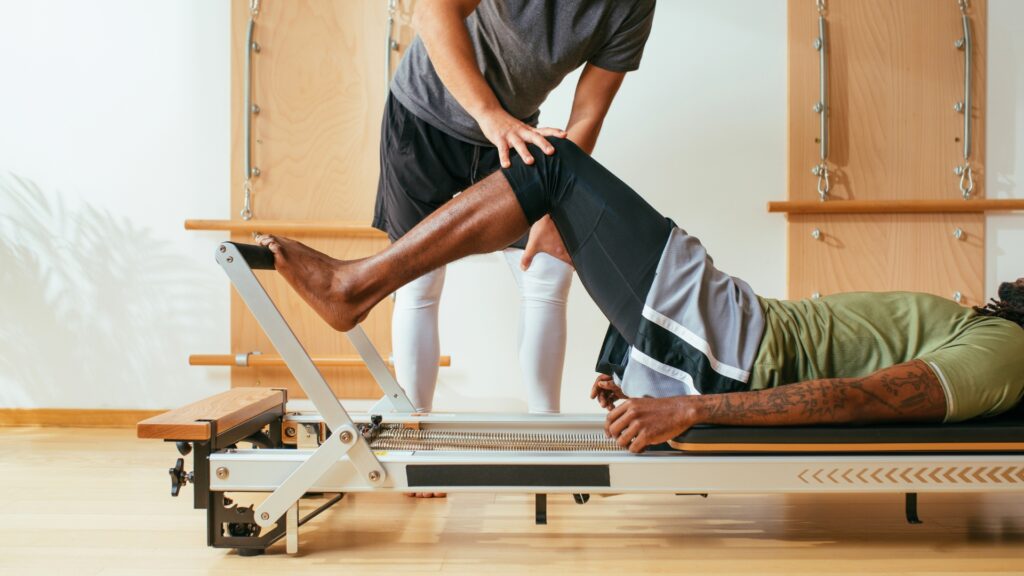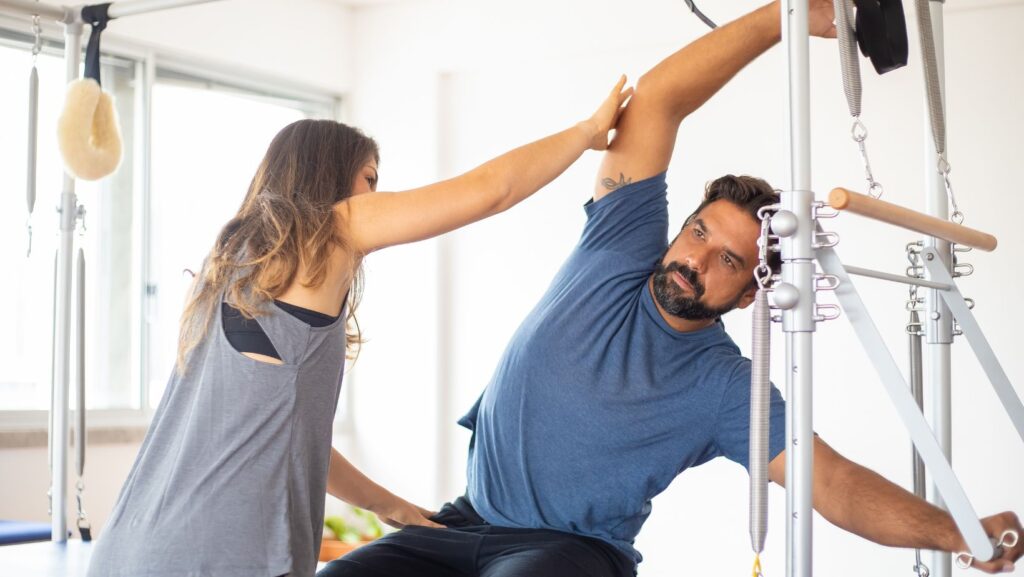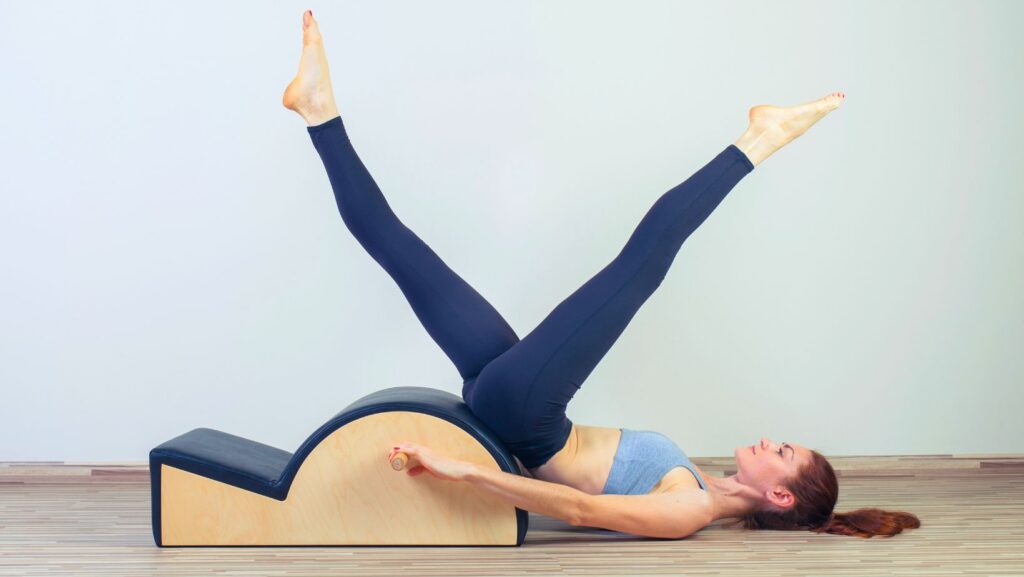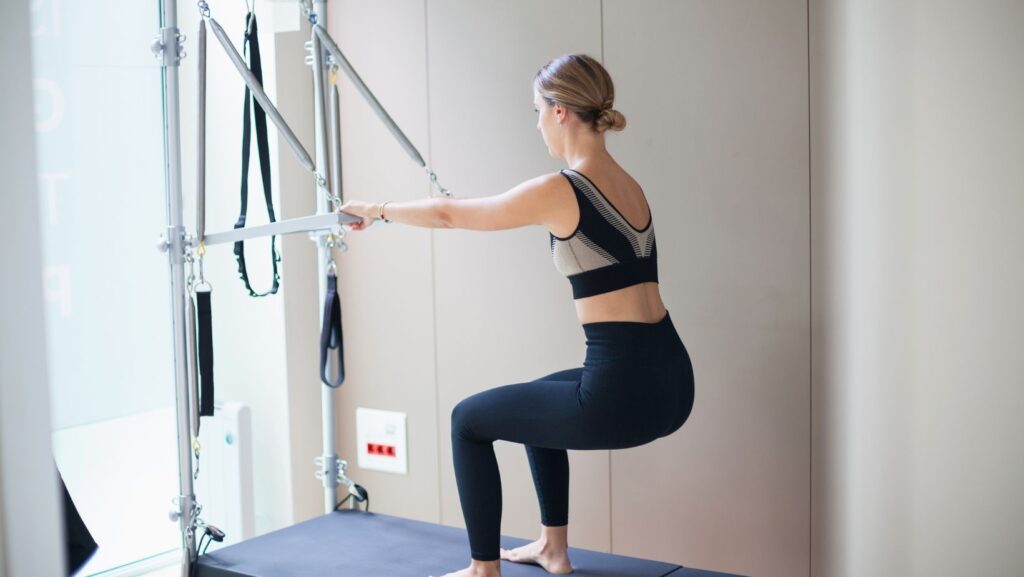Clinical Pilates vs. Pilates: Key Differences and The Value in Both
Hey! I'm Physio Ellen
Sharing the joys of Clinical Pilates with my clients is what keeps me fueled.
It would be my pleasure to show you the ins and outs so your own clients can benefit, too.
Grab my free Reformer Rehab Integration Guide
April 8, 2025
Clinical Pilates has been gaining popularity, and for good reason. There are many benefits of Clinical Pilates such as improved strength and flexibility, proprioception, balance, and posture. But these sound very much like the benefits of studio Pilates, don’t they? They can both include various apparatuses such as Reformer and Cadillac, and outwardly they can look fairly similar. So what exactly is Clinical Pilates? And what is the difference between Clinical Pilates vs. Pilates?
Perhaps you’ve heard that Clinical Pilates takes into account an individual’s specific injuries and physical condition. You may have also heard that it can be carried out by a physio as as form of exercise after an injury or surgery.
While I wholeheartedly agree with these statements, I would like to offer a deeper explanation into the true differences between Pilates and Clinical Pilates. In my opinion it’s more about the thought process behind selecting which exercises and Pilates equipment to use as well as how to teach, modify, and sequence them.
Imagine you’re choosing between a private Pilates session at a studio versus seeing a physiotherapist trained in Clinical Pilates. While it’s very possible that the exercises might look the same, the approach will differ, especially when it comes to goals, focus, and the depth of instruction.
Before we dive into the specifics, I’ll mention that it’s entirely appropriate to use identical exercises for both fitness and therapeutic purposes. After all, Pilates was developed by Joseph Pilates specifically for rehabilitation, particularly for prisoners of war during World War I. This is exactly why Pilates exercises remain incredibly useful for many health professionals.

Intention
There will always be different ways to perform an exercise safely, and Pilates is no different. The effectiveness can change dramatically depending on how we modify the focus, speed, angle/trajectory, and most importantly, intention. These subtle adjustments can shift joint and muscle engagement to produce completely different outcomes.
Take, for example, the Pilates Roll Back exercise. It’s similar to a reverse sit-up or reverse curl that involves spinal articulation between neutral spine and flexion. Inherently it is a great abdominal strengthening exercise with a bit of lumbar flexibility thrown in. But when performed in the context of Clinical Pilates, the application of this exercise can change significantly. Perhaps the goal is finding lumbar flexion without premature thoracic involvement. Or perhaps it’s controlling thoracic flexion in the absence of scapular protraction. Or it could be pelvic floor engagement with lower deep core activation on exhale.
To elaborate further, these changes of intent are often tied to a functional goal. In my experience, one of the most defining features of physiotherapy is the importance of setting functional goals. Without goals, you can’t create an effective treatment plan. Let’s say I’m working with a client who has chronic back pain and is fearful of flexing through their lumbar spine. While the Roll Back usually targets abdominal strengthening in traditional Pilates class, my goal here is different. I’ll use it specifically to improve spinal ROM and gradually desensitise the client to movements they’ve previously avoided.
Specificity and Treatment Planning
Treatment planning requires thinking at least two or three steps ahead; Where are we now, where are we going, and how do we get there in light of any limitations? The client’s daily life, medical history, sport, job requirements and/or exercise habits are all factors.
Whether they’re a professional athlete trying to return to peak performance or someone recovering from a workplace injury, everyone’s roadmap will look different.
This focus on functional outcomes is what sets Clinical Pilates apart from a typical Pilates class. Clinical Pilates hinges on working toward specific rehabilitation goals. Exercises are curated and tweaked to fit into a treatment plan.



In contrast, a regular Pilates class offers general mobility and strength exercises, but are less likely to account for an individual’s specific goals. The exception being specialty classes such as golf or running workshops. The upside of group Pilates, however, is the social support and energy that some people prefer. Personally, I enjoy group classes as opportunities for mindful meditation. I can just be in my body without talking or directly interacting with anyone else. There’s also the obvious benefit of increased affordability and accountability.
Choreography and Aesthetics
Traditionally, Pilates aims to be graceful and fluid. The choreography aspect can be a lot of fun and engaging for participants, making it a great option for those looking to get a workout while improving overall mobility and flexibility. These dynamic movements also help develop body awareness, coordination, and posture.
On the other hand, Clinical Pilates is generally less focused on choreography and flair. The main focus may be on one segment or joint with less strict correction of the rest of the body as long as safety is maintained.
This might mean that we’re not as concerned with the “polish” of the movement (like pointed toes or graceful transitions). What matters more is ensuring that each movement serves a clinical purpose.
That said, there is still a place for classical Pilates choreography within Clinical Pilates. Many traditional Pilates exercises have tremendous value in regards to general mobility, strength, and balance. In a practical sense, they just feel amazing to perform. Integrating these elements can be a fantastic adjunct to a clinical session.
The Value in Both Clinical Pilates and Regular Pilates
In essence, Clinical Pilates is a collection of Pilates exercises that have been pragmatically curated as part of a larger rehab plan. While it may use traditional Pilates exercises, the context and specific intentions may be very different based on clinical expertise, medical knowledge, clinical assessment, and differences in treatment approach.
However, with more modern forms of Pilates, therapeutic adaptations are being increasingly embraced leading to a greater amount of overlap with Clinical Pilates sessions. With some Pilates studios leaning more into the therapeutic realm, we’re seeing private sessions tailored to an individual’s limitations on top of exercises that are fun.
There is so much value in keeping clients clients engaged and motivated while they rediscover what their bodies can do. Adding a few Pilates exercises to a rehab plan just for fun is something I do frequently. One of my clients expressed that it felt like being a kid on a jungle gym again.
All in all, there are benefits to working with both Clinical Pilates and Pilates instructors. Both posess expert knowledge and training in their own respective areas. If you require a deeper, rehabilitative approach from someone with a stronger background in exercise physiology, then Clinical Pilates may be more appropriate. It can be a great introduction to Pilates before moving onto a studio for a sustainable exercise choice for overall health.
Interested in Learning More About the Benefits of Clinical Pilates?
If you’d like more information about the rehabilitative features of Pilates, see my related posts:
How the 6 Principles of Pilates Align Perfectly with Physiotherapy
leave a comment